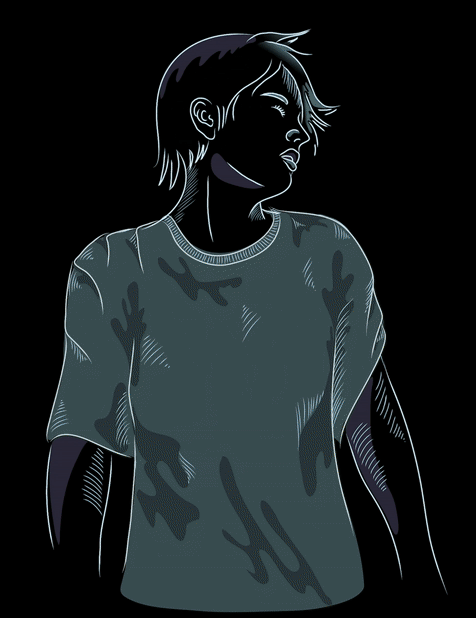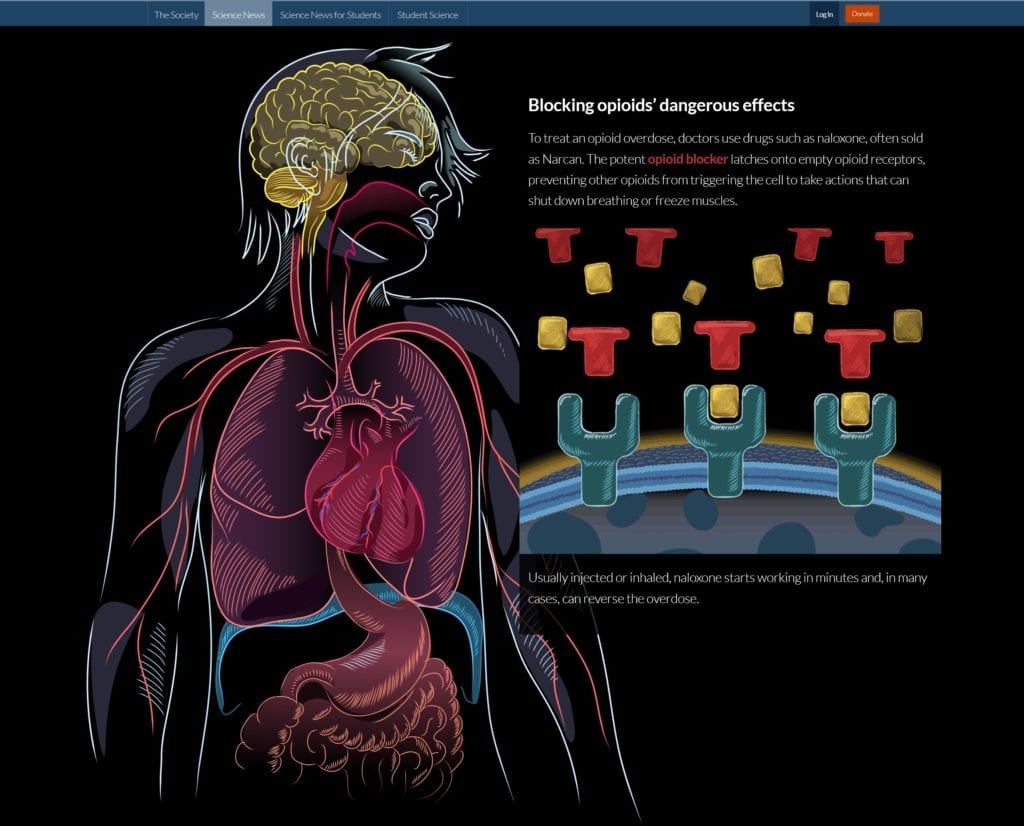Interactive Art: Understanding Opioid Addiction’s Effect on the Body
Industry: Magazine Publisher (science editorial)
Design Director: Erin Otwell
Art: Scratchboard (chalkboard) style illustration, animation, and interactive graphic
Subject: Opioid Addiction’s Effects on the Body
Opioids Art Goal and Challenges
Opioid addiction is devastating to individuals and communities across the United States. Science News Magazine invited SayoStudio to work with them to illustrate opioid drugs’ impact across the body. The goal was to interpret the underlying biological repercussions of opioid addiction with approachable interactive art.
Years before, Nicolle worked with Science News on a scratchboard style illustration—hand-drawn lines on a black background—to highlight the vagus nerve. That chalk-style medical art is still one of our favorite portfolio pieces, and it gets more requests for re-use than any other image. It became the starting point for this project’s style. Design Director Erin Otwell and her team suggested taking the digital art even further with an animated graphic story. The graphic would use an interactive format to reveal and highlight the many different parts of the body damaged by opioids.

An Introduction to the Biology of Opioids Addiction
Despite the widespread overuse of opioids—like morphine, fentanyl, and morphine—it can be easy to forget that addiction is a complex disease. As the drugs bind to the pleasure centers in the brain, they simultaneously cause problems across the body. Breathing slows and becomes more shallow, to the point that breathing stops, or there isn’t enough oxygen for the body. The body’s carbon dioxide emergency alarm is silenced by binding opioids, causing more respiratory distress. The heart and digestive system are also damaged.
Opioids Art Process and Creation
With Science News’ vision, Nicolle had a clear goal in mind for the style and she knew the breadth of the content to be illustrated. To begin, she sketched the key details to confirm that all of the components were correct. Once the sketch was approved for overall composition and scientific detail, she started on a new variety of art. Diverging from her usual process, Nicolle created the art in a ‘vector format’ rather than drawing in Photoshop. With vector art, Science News’ web-designer could create an SVG interactive animation—a lightweight animation, much like a GIF, that can be coded to change based on user input like clicks.
After hand-drawing the lines, Nicolle captured the line-work in Adobe Illustrator. The hand-drawn feel was retained through pressure-sensitive strokes, but the vector art would be lightweight for websites and apps. (Although not applicable to this project, this also allows the art to be scaled in size, as large or small as desired.) She drew each major body system affected by opioids—heart, kidney, digestion, lungs, heart, and brain—on separate layers. This way, each body system could be turned on or off as you move through the story. Nicolle sent the (meticulously-titled!) layers to the designer, so they could sync it with their text to make a truly interactive story.

Creating supplementary Graphics and Editorial Opioids Overdose Animation
Next, to communicate the fear and severity of the opioids epidemic, Nicolle created this stark GIF style animation for the story introduction. She and the team decided to keep it simple by focusing on a lone hand dropping a needle. This illustrates one of the harshest realities of addiction—the isolation that it brings.
Using Maxon’s Cinema 4D (C4D), Nicolle staged and animated the needle rolling away. She output the animation with C4D’s sketch-and-toon drawn animation style, which got it close… but the output art didn’t quite hit the mark. Nicolle imported the sequence into Photoshop and hand-drew the hatch- style shading, frame by frame. The result was a little jumpy, but also suited the jittery reality of an overdose.
Finally, she created a simple cellular graphic to show the function of anti-opioid drugs like naloxone or Narcan. Anti-opiates bind to receptors on the cell surface so that the drugs can’t. This can quickly restore breathing and reverse the dire effects.
Final Art and Achievements

The finished artwork told the opioids story in Science News’ print magazine and as a multi-step interactive article on their website and digital media. Science News and SayoStudio were honored to be recognized for their storytelling:
Winner, 2018 Ozzie Award for Visual Digital Storytelling: Opioids Kill, Laura Sanders, Nicolle Rager Fuller, Cori Vanchieri, Kate Travis, Erin Otwell, Chang Won Chang & Alison Buki
For drug addiction help, resources, and research, visit publichealth.org
